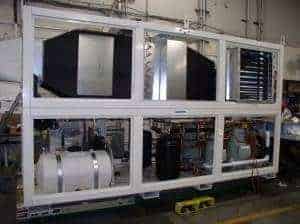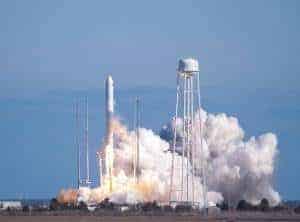The Challenge:
Air Innovations’ client and NASA partner, Orbital Sciences Corp. (now Northrop Grumman), needed to condition the key stages of the Antares rocket system – including its payload and core – during pre-launch. The rocket would be outfitted with its payload about a mile from the launch site. Then it would be towed in a horizontal position to the site, a lengthy process during which the contents of the payload section would need to be maintained at pre-set temperature, humidity, filtration, and pressurization parameters unique to that particular flight’s payload. The portable environmental control system (PECS) would need to accompany the rocket on its slow journey to the pad, steadily supplying the payload’s specific needs.
The biggest challenge in this phase was to create an aerospace-suitable environmental control system with a wide range of adjustable output temperatures (45°–85°F / 7°–29.5°C) and humidity levels (10%-60%RH) while providing once-through, steady-state air and operating in outside air and in a salt environment. This would require the environmental control unit to provide a wide range of air flows, humidification/dehumidification, cooling & heating, HEPA filtration, pressurization, and protective coatings.
Download our aerospace whitepaper: Neutralizing Nature
Once at the pad, the rocket would be raised into a vertical position, but would still require additional environmental control until launch. The custom environmental control units (ECUs) required to regulate the payload and core at this point needed to be in a fixed location in a bunker under the pad, and those ECUs needed to be managed from a remote location. The payload environmental control system required similar tolerances and specifications to the portable environmental control system, but would be water-cooled.
The ECUs designed to control conditions in the three bays of the rocket’s stage-1 core also needed to operate over a wide range (50°–100°F / 10°–38°C) using outside salt-air, but with a variable maximum dew-point setting. The typical dew point maximum for “core” cooling ECUs would be 45°F (7°C), but that dew point would need to drop significantly – to a dew point of -7.6°F (-22°C) – to allow the fueling process to begin. [Note: Rocket fuel is delivered at very low temperatures, and if the dew point of the external air is higher than the temperature of the rocket fuel delivery system, icing occurs. This is a very dangerous condition that you would want to avoid during a launch.]
The Solution:
Air Innovations applied knowledge from designing and manufacturing other aerospace environmental control systems to facilitate a solution to the complex challenges inherent in this application (e.g. an explosion-proof, Class 1, Division II system that provides low humidity to a payload during the installation process and is located in salt-air conditions on the U.S. West Coast at a facility where satellites are flown into polar orbit).
Air Innovations built an air-cooled, portable environmental control system (PECS) on a 25-foot trailer for the trip from the payload-outfitting location to the pad. The company also designed and built three water-cooled environmental control units (ECUs) for the pad location: one for the payload and two systems (with multiple subsystems) for the core. [Note: All of these systems were among the largest ever designed and manufactured by Air Innovations.]
Each of the aerospace environmental control units for the payload (both fixed and portable) provides 1100 to 2200 cubic feet minute (cfm) airflow, 27 tons of cooling, and 60kW of heating. The fixed ECUs that regulate conditions for the core provide 1200 to 2400 cfm airflow, 45 tons of cooling, and 65kW of heat apiece; in addition to two in-line desiccant dryers that help achieve the required dew point of -7.6°F (-22°C) for fueling the rocket. Units were configured to provide once-through, steady-state air.
The Result:
Orbital’s Antares rockets (test launch and those destined for the International Space Station) were successfully launched from the new Mid-Atlantic Regional Spaceport (MARS) at the agency’s Wallops Flight Facility in Virginia.
- All design specifications were met for each of the three types of environmental control systems:
- PECS (portable environmental control system for payload cooling during transportation),
- Payload (water-cooled system at the platform for payload cooling), and
- Core (water-cooled systems at the platform for regulating the stage-1 core)
- The environmental control systems included cooling, heating, humidification/dehumidification, and filtration:
- 27- or 45-ton nominal cooling with electronic evaporator pressure regulating refrigeration control per system
- 60-65kW of heating per system
- 70 lbs/hr nominal humidification in PECS and payload environmental control systems.
- Integral HEPA filtration to meet ISO Class 7 standards in PECS and payload ECUs
- Desiccant drying in ECUs for maintaining a low dew point during fueling
- Output Conditions:
- 45° to 85°F (7° to 29.5°C) at 10% to 60% relative humidity on the portable environmental control system and fixed payload cooling ECU
- 50°–100°F (10°–38°C) at a max dew point of 45°F (7°C), switching to a max dew point of -7.6°F (-22°C) on the core ECUs
- 1100 – 2200 or 1200 – 2400 CFM variable airflow operational range
If you’re ready for a custom solution from Air Innovations (just like this custom linear accelerator cooling system), contact us by submitting a quick Project Inquiry or by calling 1-800-835-3268 today. We’re looking forward to talking to you!
Our Aerospace Environmental Control Systems page goes over more of our work within the aerospace industry. If you would like to see additional case studies for aerospace and other industries, visit our general case studies page.
Click here to download our aerospace whitepaper “Neutralizing Nature” which outlines some of the challenges of environmental control in aerospace applications. We also have whitepapers available covering the pharmaceutical industry, the semiconductor industry, and our Micro Environments product line. These whitepapers can be found here.



